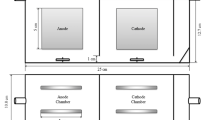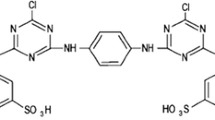Abstract
The assessment of chromium removal efficiency (CRE) was studied using experimental trials with variations in operating conditions for evaluating performance efficiency of the Bioelectrochemical system (BES). During the study, maximum CRE of 88.36 ± 8.16% was obtained at cathode pH 2 ± 0.1 from the varied cathode pH (pH 1, 2, 3, 4, 5, 6, 7). With varying reactor temperatures from 25 to 45 °C (25, 30, 35, 40, 45 °C), BES resulted in maximum CRE of 85.93 ± 9.62% at 40 °C. CRE increased from 78.50 ± 5.24 to 88.66 ± 8.40% with an increase in substrate concentration from 500 to 2000 mg/L chemical oxygen demand (COD). CRE decreased from 95.9 ± 2.9 to 89.56 ± 1.74% with an increase in initial chromium concentration from 10 to 100 mg/L. Correlation analysis revealed a positive correlation with COD reduction, COD, and temperature, whereas a negative correlation was observed for pH and initial chromium concentration.





Similar content being viewed by others
References
Singh R, Gautam N, Mishra A, Gupta R (2011) Heavy metals and living systems: an overview. Indian J Pharmacol 43:246
Ruus A, Schaanning M, Øxnevad S, Hylland K (2005) Experimental results on bioaccumulation of metals and organic contaminants from marine sediments. Aquat Toxicol 72:273–292
Chattopadhyay B, Chatterjee A, Mukhopadhyay SK (2002) Bioaccumulation of metals in the East Calcutta wetland ecosystem. Aquat Ecosyst Health Manag 5:191–203
Bakalár T, Búgel M, Gajdošová L (2009) Heavy metal removal using reverse osmosis. Acta Montan Slovaca 14:250
Fu F, Wang Q (2011) Removal of heavy metal ions from wastewaters: a review. J Environ Manage 92:407–418
Falk G, Litz C, Taylor R (2000) Wastewater technology fact sheet chemical precipitation. United States Environmental Protection Agency, Washington, D.C.
Kurniawan TA, Chan GYS, Lo WH, Babel S (2006) Physico-chemical treatment techniques for wastewater laden with heavy metals. Chem Eng J 118:83–98
Kim C, Lee CR, Song YE, Heo J, Choi SM, Lim DH, Cho J, Park C, Jang M, Kim JR (2017) Hexavalent chromium as a cathodic electron acceptor in a bipolar membrane microbial fuel cell with the simultaneous treatment of electroplating wastewater. Chem Eng J 328:703–707
Xafenias N, Zhang Y, Banks CJ (2013) Enhanced performance of hexavalent chromium reducing cathodes in the presence of Shewanella oneidensis MR-1 and lactate. Environ Sci Technol 47:4512–4520
Habibul N, Hu Y, Wang YK, Chen W, Yu HQ, Sheng GP (2016) Bioelectrochemical chromium(VI) removal in plant-microbial fuel cells. Environ Sci Technol 50:3882–3889
Zhang Y, Yu L, Wu D, Huang L, Zhou P, Quan X, Chen G (2015) Dependency of simultaneous Cr(VI), Cu(II) and Cd(II) reduction on the cathodes of microbial electrolysis cells self-driven by microbial fuel cells. J Power Sources 273:1103–1113
Li Y, Lu A, Ding H, Jin S, Yan Y, Wang C, Zen C, Wang X (2009) Cr(VI) reduction at rutile-catalyzed cathode in microbial fuel cells. Electrochem Commun 11:1496–1499
Wang H, Ren ZJ (2013) A comprehensive review of microbial electrochemical systems as a platform technology. Biotechnol Adv 31:1796–1807
Wang H, Ren ZJ (2014) Bioelectrochemical metal recovery from wastewater: a review. Water Res 66:219–232
Logan BE, Hamelers B, Rozendal R, Schröder U, Keller J, Freguia S, Aelterman P, Verstraete W, Rabaey K (2006) Microbial fuel cells: methodology and technology. Environ Sci Technol 40:5181–5192
Sleutels THJA, Ter Heijne A, Buisman CJN, Hamelers HVM (2012) Bioelectrochemical systems: an outlook for practical applications. ChemSusChem 5:1012–1019
Nancharaiah YV. Mohan SV, Lens PNL (2015) Biological and bioelectrochemical recovery of critical and scarce metals. Trends Biotechnol 29:137–155
Mohan SV, Velvizhi G, Modestra JA, Srikanth S (2014) Microbial fuel cell: critical factors regulating bio-catalyzed electrochemical process and recent advancements. Renew Sustain Energy Rev 40:779–797
Li W-W, Yu H-Q, He Z (2014) Towards sustainable wastewater treatment by using microbial fuel cells-centered technologies. Energy Environ Sci 73:911–924
Baranitharan E, Khan MR, Prasad DM, Teo WF, Tan GY, Jose R (2015) Effect of biofilm formation on the performance of microbial fuel cell for the treatment of palm oil mill effluent. Bioprocess Biosyst Eng 38:15–24
Lovley DR, Phillips EJ (1998) Novel mode of microbial energy metabolism: organic carbon oxidation coupled to dissimilatory reduction of iron or manganese. Appl Environ Microbiol 54:1472–1480
APHA (2012) Standard methods for water and wastewater examination. American Public Health Association, Washington DC
Wang G, Huang L, Zhang Y (2008) Cathodic reduction of hexavalent chromium [Cr(VI)] coupled with electricity generation in microbial fuel cells. Biotechnol Lett 30:1959–1966
Li Z, Zhang X, Lei L (2008) Electricity production during the treatment of real electroplating wastewater containing Cr6+ using microbial fuel cell. Process Biochem 43:1352–1358
Patil SA, Harnisch F, Kapadnis B, Schröder U (2010) Electroactive mixed culture biofilms in microbial bioelectrochemical systems: the role of temperature for biofilm formation and performance. Biosens Bioelectron 26:803–808
Chae KJ, Jang A, Yim SK, Kim IS (2008) The effects of digestion temperature and temperature shock on the biogas yields from the mesophilic anaerobic digestion of swine manure. Bioresour Technol 99:1–6
Min B, Román ÓB, Angelidaki I (2008) Importance of temperature and anodic medium composition on microbial fuel cell (MFC) performance. Biotechnol Lett 30:1213–1218
Behera M, Murthy SSR, Ghangrekar MM (2011) Effect of operating temperature on performance of microbial fuel cell. Water Sci Technol 64:917–922
Tee PF, Abdullah MO, Tan IAW, Amin MAM, Nolasco-Hipolito C, Bujang K (2017) Effects of temperature on wastewater treatment in an affordable microbial fuel cell-adsorption hybrid system. J Environ Chem Eng 5:178–188
Sun G, Thygesen A, Meyer AS (2015) Acetate is a superior substrate for microbial fuel cell initiation preceding bioethanol effluent utilization. Appl Microbiol Biotechnol 99:4905–4915
Chae KJ, Choi MJ, Lee JW, Kim KY, Kim IS (2009) Effect of different substrates on the performance, bacterial diversity, and bacterial viability in microbial fuel cells. Bioresour Technol 100:3518–3525
Jadhav GS, Ghangrekar MM (2009) Performance of microbial fuel cell subjected to variation in pH, temperature, external load and substrate concentration. Bioresour Technol 100:717–723
Lefebvre O, Neculita CM, Yue X, Ng HY (2012) Bioelectrochemical treatment of acid mine drainage dominated with iron. J Hazard Mater 241:411–417
Huang L, Chen J, Quan X, Yang F (2010) Enhancement of hexavalent chromium reduction and electricity production from a biocathode microbial fuel cell. Bioprocess Biosyst Eng 33:937–945
Gangadharan P, Nambi IM (2015) Hexavalent chromium reduction and energy recovery by using dual-chambered microbial fuel cell. Water Sci Technol 71:353–358
Tao HC, Li W, Liang M, Xu N, Ni JR, Wu WM (2011) A membrane-free baffled microbial fuel cell for cathodic reduction of Cu(II) with electricity generation. Bioresour Technol 102:4774–4778
Qin B, Luo H, Liu G, Zhang R, Chen S, Hou Y, Luo Y (2012) Nickel ion removal from wastewater using the microbial electrolysis cell. Bioresour Technol 121:458–461
Choi C, Cui Y (2012) Recovery of silver from wastewater coupled with power generation using a microbial fuel cell. Bioresour Technol 107:522–525
Yeon RE, Kim M, Lee SJ (2011) Characterization of microbial fuel cells enriched using Cr(VI)-containing sludge. J Microbiol Biotechnol 21:187–191
Luo H, Qin B, Liu G, Zhang R, Tang Y, Hou Y (2014) Selective recovery of Cu2+ and Ni2+ from wastewater using bioelectrochemical system. Front Environ Sci Eng 9:522–527
Acknowledgements
The authors thank the financial support received from Indian Institute of Technology (Indian School of Mines), Dhanbad under a Junior Research Fellowship scheme funded by Ministry of Human Resource Development (MHRD), Government of India, New Delhi, India for carrying out this study.
Author information
Authors and Affiliations
Corresponding author
Ethics declarations
Conflict of interest
The authors declare that they have no conflict of interests. This article does not contain any studies conducted with animals performed by any of the authors.
Research involving human/animal rights
This article does not contain any studies conducted with animals performed by any of the authors.
Rights and permissions
About this article
Cite this article
More, A.G., Gupta, S.K. Evaluation of chromium removal efficiency at varying operating conditions of a novel bioelectrochemical system. Bioprocess Biosyst Eng 41, 1547–1554 (2018). https://doi.org/10.1007/s00449-018-1982-4
Received:
Accepted:
Published:
Issue Date:
DOI: https://doi.org/10.1007/s00449-018-1982-4




